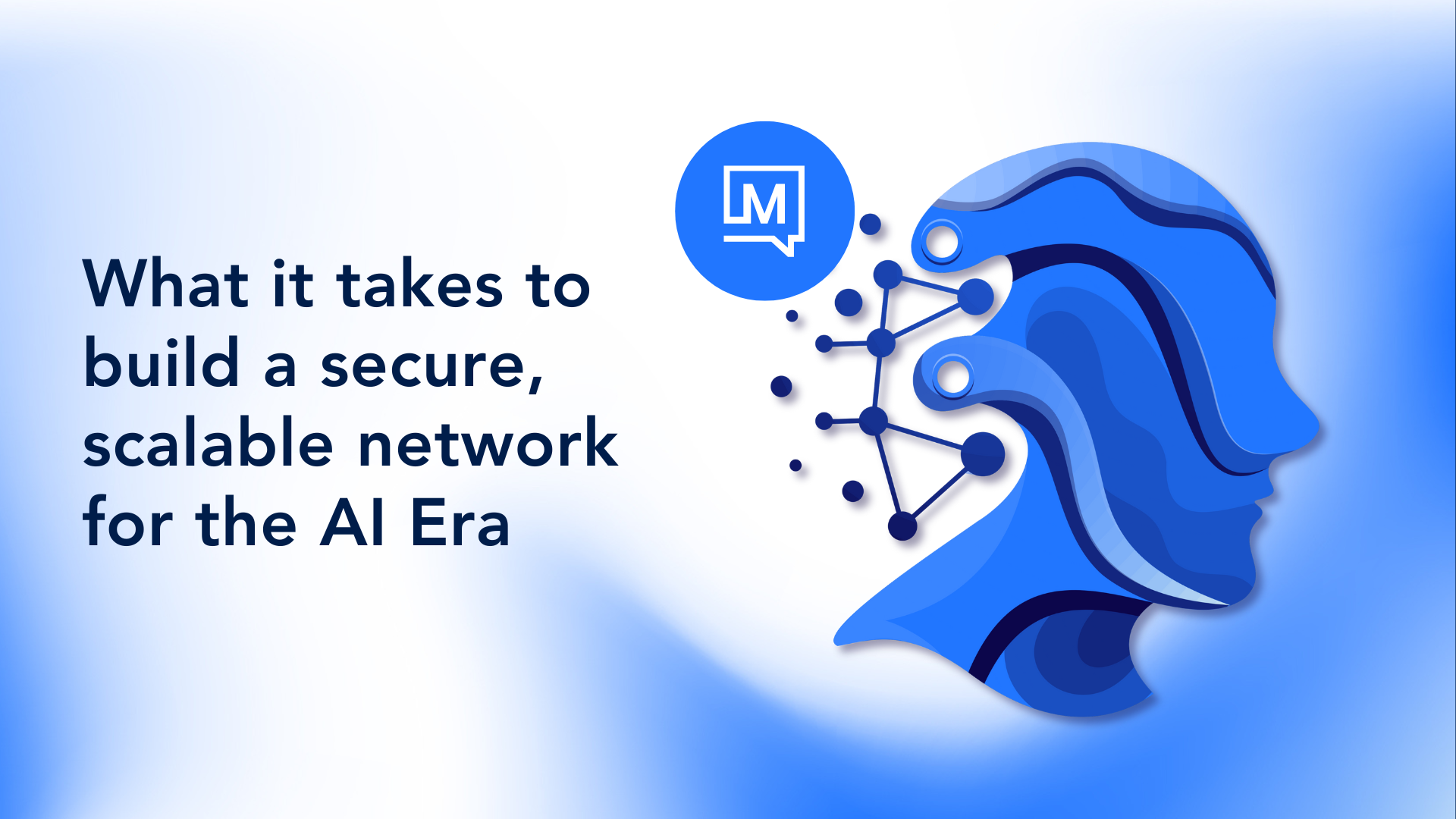Companies are investing heavily in artificial intelligence, but most overlook one critical factor: their network infrastructure isn’t built to support the massive demands of AI workloads.
The reality is clear: only 13% of businesses globally feel fully prepared to leverage AI’s capabilities effectively.
This readiness gap means organizations risk severe latency issues, data bottlenecks, and increased vulnerability to cyber threats, undermining their significant investments in AI.
Consider healthcare organizations relying on real-time AI diagnostics, where even minor latency can affect patient outcomes. Or retail enterprises using AI-driven analytics that fail due to inadequate network capacity, directly impacting customer experience and revenues.
Succeeding in this new era of AI-driven transformation requires more than incremental upgrades. Businesses must fundamentally transform their networks into agile, secure, and scalable infrastructures, ready to handle intense data loads, minimize latency, and maintain robust security measures.
Here’s how organizations can use Software-Defined Wide Area Networks (SD-WAN) to build the intelligent network backbone essential for thriving in the age of AI.
Related Content: 5 Compelling SD-WAN Use Cases You Need to Know
Why most networks fall short in supporting AI
AI workloads aren’t just intensive—they’re relentless. Traditional network infrastructures were never designed to manage the sheer volume and velocity of data AI demands.
Key challenges today include:
- Massive data volumes: AI applications constantly ingest and analyze vast data streams. Think of an e-commerce platform using AI to personalize thousands of transactions per second, or a healthcare system crunching real-time patient data to predict outcomes. Networks built years ago simply can’t keep up with this relentless flood of information, creating bottlenecks that cripple performance.
- Latency sensitivity: AI-driven services, like autonomous vehicles or financial trading platforms, depend on ultra-low latency. Milliseconds of delay can mean the difference between success and failure, or even safety and risk. Traditional networks, optimized primarily for bandwidth, not speed, struggle to meet these stringent requirements.
- Complex, distributed architectures: AI doesn’t live in one place anymore. It spans on-premises data centers, public clouds, and edge locations. A manufacturing company might use edge computing to detect defects on the factory floor, then instantly relay insights to central analytics systems. Legacy networks can’t reliably handle such distributed and interconnected operations at scale.
- Security exposure: Every new AI endpoint, from cloud environments to edge devices, expands the attack surface. Without integrated security designed specifically for distributed data, businesses face increased vulnerability. The financial and reputational damage from breaches grows significantly. Global cybercrime costs are expected to reach $10.5 trillion by the end of 2025.
These are more than just technical hurdles. They directly threaten business agility, customer satisfaction, and profitability. To address these critical issues, companies are turning to SD-WAN, a modern, intelligent networking approach built specifically to overcome AI’s demanding requirements.
How SD-WAN powers networks for the AI era
Businesses serious about leveraging AI can’t rely on legacy networks—they need something smarter. That’s why many are turning to SD-WAN. Rather than merely patching up outdated infrastructure, SD-WAN fundamentally transforms how data moves through your network, directly addressing AI’s toughest demands.
Here’s why SD-WAN is quickly becoming a foundational technology for AI-ready networks:
Optimized performance for high AI demands
SD-WAN dynamically prioritizes and routes network traffic based on application requirements. For instance, AI-driven customer service platforms need constant, fast data flow. SD-WAN ensures these critical workloads get priority, avoiding slowdowns and maintaining seamless customer experiences.
Built-in scalability and flexibility
With traditional networks, scaling infrastructure to meet AI data demands means hefty costs and lengthy delays. SD-WAN, however, lets businesses scale resources seamlessly, without extensive hardware upgrades. Think of a fast-growing fintech startup rapidly expanding its AI-driven transaction platform—SD-WAN helps accommodate growth without missing a beat.
Significant cost savings
By intelligently combining private circuits with more affordable internet-based connections, SD-WAN dramatically reduces reliance on expensive MPLS links. Companies typically see substantial cost reductions, with SD-WAN deployments generating double-digit savings on average when compared to traditional WANs.

Simplified network management
Managing an AI-driven network shouldn’t require endless manual configurations. SD-WAN centralizes control, giving IT teams straightforward, real-time oversight across all locations and endpoints. For instance, a large retail chain can quickly deploy consistent AI-driven applications across thousands of stores without the hassle of managing each location individually.
Companies adopting SD-WAN are already seeing real results. After all, businesses that leverage SD-WAN are solving network challenges while also positioning themselves to fully harness AI’s transformative potential as it continues to evolve.
Related Content: How AI-Powered SD-WAN Enables More Resilient and Efficient Networks
How to integrate security to protect your AI-ready network
As businesses extend their networks to embrace AI, security complexities grow rapidly. Each AI-driven device or endpoint adds another entry point for cyber threats, dramatically expanding your vulnerability. Integrating robust security directly into the fabric of your network is essential. It can’t be an afterthought.
Here’s what effective, built-in security looks like in an AI-ready network:
- Zero trust architecture: A Zero Trust approach means assuming nothing and verifying everything. Every device and every connection must be authenticated continuously. Imagine a remote workforce accessing sensitive financial analytics powered by AI. Zero Trust ensures each connection is rigorously authenticated, greatly reducing the risk of breaches.
- End-to-end encryption: Your data’s journey across networks, whether local or global, must be fully encrypted, ensuring that data in transit stays secure from hackers. For example, a healthcare provider transmitting AI-driven patient diagnostics between facilities fully complies with HIPAA regulations and protects patient privacy.
- Real-time threat detection and response: Modern network security leverages AI itself to detect and respond to anomalies or threats instantly. Suppose an e-commerce company’s network suddenly registers unusual traffic spikes. Integrated AI security can immediately identify, isolate, and mitigate this threat before it becomes damaging.
- Compliance and governance built-in: With increasingly strict regulations, your network must consistently comply with global standards like GDPR or industry-specific rules. Integrated compliance means you’re always audit-ready, reducing risk and maintaining customer trust.
Ignoring network security’s urgency has severe consequences. Building security directly into your SD-WAN infrastructure protects your business, data, and reputation.
Related Content: How to capture data and build AI readiness
Global connectivity: Bridging geographies and platforms
Any company operating in the AI era knows global connectivity isn’t a luxury anymore. Today, it’s an absolute necessity.
Traditional networks fail when asked to provide consistent performance across vast distances, leaving businesses vulnerable to slowdowns, service outages, and lost opportunities. SD-WAN addresses these critical issues, making robust global connectivity a reality.
Seamless integration with cloud providers
Many AI-driven workloads rely heavily on cloud environments like AWS, Azure, or Google Cloud.
However, reliably connecting to these clouds across multiple global locations creates serious challenges for traditional WAN architectures, causing bottlenecks, latency spikes, and inconsistent user experiences.
With SD-WAN, enterprises achieve frictionless cloud integration. Intelligent traffic routing automatically selects the optimal path to the cloud, maintaining consistent performance across every location.
For example, if a global tech firm is deploying an AI-driven customer support platform, SD-WAN ensures every global office accesses cloud resources at maximum speed and reliability, eliminating performance dips that frustrate employees and customers.
Real-time performance through edge computing
AI applications increasingly rely on edge computing to handle real-time data.
Think of autonomous vehicles needing split-second analytics for safety-critical decisions or smart factories employing AI-driven sensors for instant operational adjustments.
Traditional WAN architectures struggle here, as their centralized structures lead to higher latencies.
SD-WAN excels here because it decentralizes network traffic management. Intelligent routing mechanisms push computing resources closer to data sources, significantly reducing latency. This results in immediate, real-time responses wherever they’re needed, whether on a remote factory floor or at the edge of a city’s traffic grid.
Resilience and redundancy for mission-critical operations
Nothing hurts business continuity like unexpected downtime.
For traditional WANs, maintaining consistent uptime across global operations often means complex, costly redundancies and manual intervention when disruptions occur. These disruptions usually result in hours of lost productivity and revenue.
SD-WAN builds resilience directly into the network fabric. Automated failover and intelligent redundancy quickly reroute traffic around failures or congested paths without manual intervention.
Imagine a global financial services company running AI-driven fraud detection where SD-WAN instantly reroutes critical data streams around network issues, ensuring continuous operation, protecting client assets, and maintaining trust.
Unified network management
As companies grow globally, network complexity skyrockets. Traditional WANs require separate management across regions, creating confusion, inconsistent policies, and security gaps.
This scattered approach not only inflates operational costs but also introduces avoidable vulnerabilities and inefficiencies.
SD-WAN simplifies global management significantly. A single, centralized dashboard provides clear visibility and control over every endpoint and link worldwide. This unified management empowers IT teams to set and enforce consistent policies universally, rapidly troubleshoot issues, and optimize performance seamlessly.
In retail, this could mean quickly rolling out a new AI-powered customer loyalty app across thousands of stores worldwide. Using SD-WAN, it’s managed instantly and consistently from one interface, rather than across hundreds of separate configurations.
Related Content: SD-WAN vs. SASE: Which One Does Your Business Need?
Building an AI-ready future starts with your network
Your ability to use AI effectively depends on the strength and agility of your network infrastructure.
Traditional networks simply can’t handle the explosive data growth, ultra-low latency demands, and expansive global footprints required by today’s AI-driven businesses. They introduce risks, bottlenecks that stall innovation, vulnerabilities that expose your company to cyber threats, and operational complexities that drain resources and impact business agility.
SD-WAN solves these challenges, transforming your network from a business liability into a strategic advantage by providing:
- Optimized performance for cloud and edge computing
- Integrated security to protect your data wherever it travels
- Unmatched resilience to keep your global operations running smoothly
With centralized management and intelligent routing, SD-WAN delivers the agility, security, and scalability that modern AI workloads demand.
Need help building a network that can support AI workloads, but are unsure where to start with SD-WAN? Learn more about how our SD-WAN solutions can simplify your network, secure your data, and scale effortlessly as your business grows.



